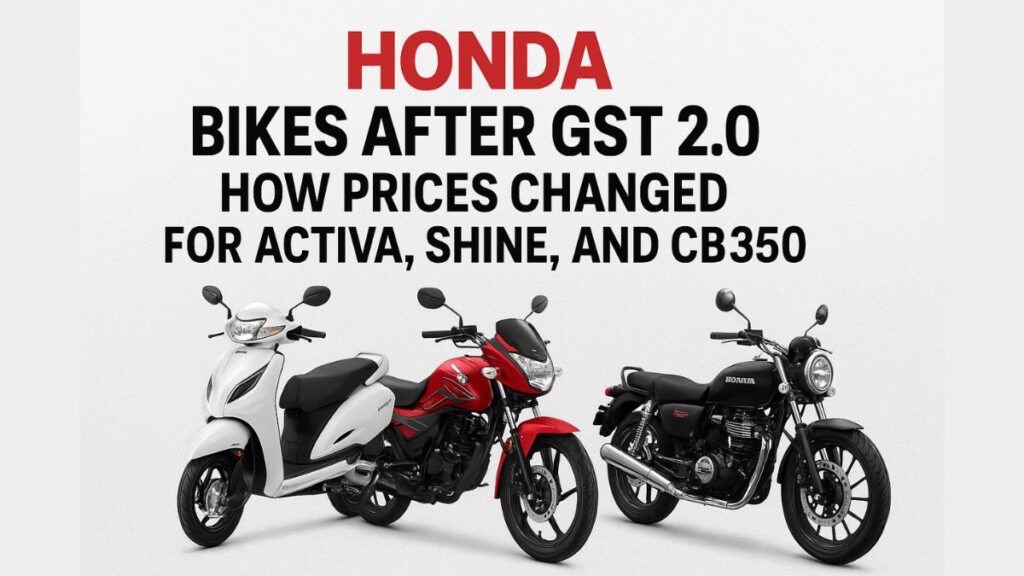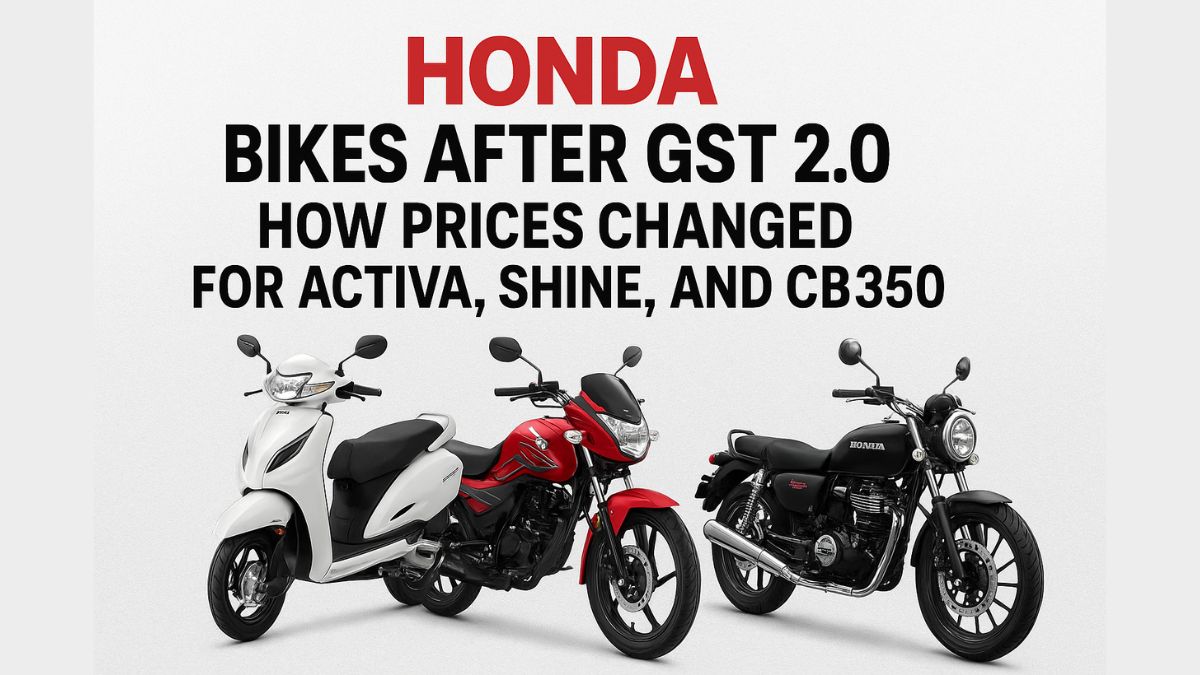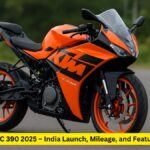Table of Contents
Honda Bikes After GST: Prices, Market Impact, and Future Outlook
Honda Bikes After GST and the Changing Two-Wheeler Market
The two-wheeler industry in India has always been sensitive to price changes, taxes, and government policies. Honda, one of the largest and most trusted bike and scooter manufacturers in the country, has seen its journey shaped by the Goods and Services Tax (GST) since its introduction in July 2017. For buyers, GST simplified the earlier complex tax structure, while for Honda, it opened new opportunities in both urban and rural markets.
Before GST, two-wheeler prices varied across states because of multiple taxes like excise duty, VAT, road tax, and cess. After GST, the system became simpler, with most two-wheelers taxed under a uniform slab. This gave Honda better flexibility in pricing and helped customers enjoy more predictable costs.
Fast forward to 2025, and a new tax cut under GST 2.0 has brought even bigger changes. Bikes and scooters below 350cc now fall under 18% GST, down from 28%. This decision impacts almost all Honda models because most of them are below the 350cc segment. For customers, this means direct savings ranging from ₹7,000 to ₹18,000 depending on the model. For Honda, it means better affordability, more sales, and stronger market share.
The story of honda bikes after gst is not just about prices, but also about growth, innovation, and long-term impact on the Indian market. Let’s explore this in detail.
The Pre-GST Era: Challenges and Higher Prices
Honda entered India in 1999 with Honda Motorcycle & Scooter India (HMSI). Its first big hit was the Honda Activa scooter launched in 2001, which quickly became a household name. But during the pre-GST era, the pricing of two-wheelers was affected by multiple taxes.
For example, in high-VAT states, buyers often paid 30–35% tax in total, making two-wheelers less affordable. A model like the Honda Activa, which should have cost around ₹45,000 ex-showroom, could go up to ₹50,000 or more because of state-level VAT.
Honda’s commuter motorcycles like the Unicorn and Shine also faced price pressures, which affected rural buyers the most. Despite these challenges, Honda managed to build a strong base with reliable scooters and motorcycles. But the company, like the rest of the industry, was waiting for a more uniform tax system.
Quick Timeline Before GST
| Year | Key Milestone |
|---|---|
| 1999 | Honda Motorcycle & Scooter India (HMSI) founded |
| 2001 | Launch of Honda Activa |
| 2010 | Hero-Honda partnership ended |
| 2016 | Honda crossed 5 million annual sales |
This set the stage for GST, which arrived in 2017.
2017 GST Impact: Price Changes for Honda Bikes
When GST was rolled out in July 2017, two-wheelers under 350cc were placed under the 28% tax slab. Earlier, the combined tax burden was often more than 30%. So, GST led to a small but meaningful reduction in prices for most Honda models.
Example of Price Change After 2017 GST
| Model | Pre-GST Price (Approx.) | Post-GST Price (2017) | Savings |
|---|---|---|---|
| Honda Activa 110 | ₹48,000 | ₹45,500 | ₹2,500 |
| Honda CB Shine | ₹56,268 | ₹50,418 | ₹5,850 |
| Honda Unicorn | ₹71,000 | ₹68,000 | ₹3,000 |
Honda immediately passed on these benefits to customers. This helped the company improve its sales. In July 2017, Honda sold over 5.4 lakh units, showing strong demand even after the confusion around GST implementation.
The uniform tax also made pricing more transparent across states. Customers no longer faced sharp differences in bike costs from one state to another, which improved Honda’s reach in rural and semi-urban markets.
Model Growth and Innovations After GST
One of the biggest outcomes of GST for Honda was the ability to plan better for the future. The company used this stability to launch several new models and upgrade existing ones.
Between 2017 and 2025, Honda expanded both its commuter and premium lineups, making sure it had something for every segment of buyers.
Key Honda Launches and Updates After GST
- 2017–2019: Honda focused on scooters and entry-level commuters. Activa updates, Shine upgrades, and the Livo were key products during this phase.
- 2020–2022: Honda entered the premium retro segment with the CB350 H’ness and CB350RS. Activa 6G was also launched in 2020 with new features like idle start-stop.
- 2023–2024: The SP125 received updates for OBD2 compliance. Honda also launched the CB200X and the NX500 adventure bike.
- 2025: The CB125 Hornet and Shine 100 DX were introduced to strengthen the commuter lineup.
Honda Bikes After GST: Price Ranges (2025)
| Model | Price Range (₹) | Segment |
|---|---|---|
| Activa 125 | 80,000–90,000 | Scooter |
| Shine 125 | 75,000–85,000 | Commuter |
| CB350 H’ness | 2.1–2.3 lakh | Premium Retro |
| CB125 Hornet | 90,000–1 lakh | Sporty 125cc |
| NX500 | 5.9 lakh | Adventure |
This mix of affordable scooters, reliable commuters, and stylish premium bikes has helped Honda expand its reach. And because most of these bikes fall under 350cc, they benefit directly from GST cuts.
Honda’s Market Share and Sales Performance
Honda’s growth after GST can be clearly seen in its sales figures. In 2017, Honda sold about 4.5 million units. By 2024, sales crossed 5 million annually, making it one of the top two players in India’s two-wheeler market.
Honda Sales Growth After GST
| Year | Sales (Million Units) | YoY Growth |
|---|---|---|
| 2017–18 | 4.5 | 20% |
| 2020–21 | 4.0 (COVID dip) | – |
| 2024–25 (Proj.) | 5.5 | 15% |
Scooters, especially the Activa, continue to dominate sales. At the same time, motorcycles like the Shine and CB series have built strong followings. GST has made pricing consistent, which gave Honda the edge in both cities and rural areas.
GST 2.0 in 2025: Big Relief for Honda Buyers
In September 2025, the government introduced GST 2.0, which reduced the GST rate on two-wheelers below 350cc from 28% to 18%. This move covers almost the entire Honda lineup because most of its scooters and bikes are under 350cc.
For buyers, the new GST cut means direct price reductions. Honda confirmed that the entire benefit will be passed on to customers.
Honda Bikes After GST 2.0: Price Reductions
| Model | Old Price (₹) | New Price (₹) | Savings (₹) |
|---|---|---|---|
| Activa 110 | 85,000 | 77,126 | 7,874 |
| CB350RS | 2.25 lakh | 2.06 lakh | 18,887 |
| Shine 125 | 85,000 | 74,400 | 10,600 |
| Dio | 78,000 | 70,843 | 7,157 |
The savings are significant, especially for families and first-time buyers. A commuter motorcycle like the Shine becomes more affordable for rural users, while premium options like the CB350 see major cuts of nearly ₹19,000.
Why GST Cuts Matter for Honda Bikes
The two-wheeler market in India is highly price-sensitive. Even a difference of ₹5,000 can influence buying decisions. By reducing GST to 18%, Honda bikes become more attractive to buyers who earlier delayed or cancelled purchases due to high costs.
Some key reasons this change matters:
- Higher Affordability: Scooters like Activa and Dio now fall closer to the ₹70,000 range, which is easier for middle-class buyers.
- Stronger Rural Demand: Savings of ₹10,000 or more on commuter bikes like Shine will boost sales in rural markets.
- Premium Push: Even though Honda’s premium bikes above 350cc face 40% GST, most of its sales are below this range, so the impact is largely positive.
- Dealer Benefits: More affordable pricing means higher volumes, which improves dealer margins and growth.
The Road Ahead for Honda Bikes After GST
Looking ahead, Honda plans to grow its market share from around 27% in 2024 to 30% by 2030. GST benefits will play a big role in achieving this goal. The company also plans to expand its electric vehicle lineup, with the Activa Electric expected soon.
However, challenges remain. Fuel prices, competition from Hero and TVS, and the rising demand for EVs will test Honda’s adaptability. Still, with its strong lineup, affordable pricing after GST, and wide network, Honda is well-positioned to lead.
FAQs on Honda Bikes After GST
1. What is the impact of GST on Honda bike prices?
After GST 2.0 in 2025, Honda bikes under 350cc are now taxed at 18% instead of 28%, making them cheaper by ₹7,000–₹18,000 depending on the model.
2. Which Honda models got the highest price cut after GST 2.0?
The Honda CB350 series got the biggest reduction of nearly ₹19,000, while Activa and Shine also saw cuts between ₹7,000 and ₹10,000.
3. Do premium Honda bikes above 350cc benefit from GST cuts?
No. Bikes above 350cc are now under the 40% GST slab, which makes them costlier. The main benefit is for commuter and scooter segments.
4. How has GST helped Honda grow in India?
GST simplified taxes, stabilized prices, and improved affordability. This boosted Honda’s sales from 4.5 million units in 2017 to over 5 million in 2024.
5. Will Honda pass on full GST benefits to customers?
Yes, Honda has confirmed that it will transfer the entire GST benefit to buyers, reducing showroom prices across its lineup.

Honda Bikes After GST – A Stronger Future Ahead
The journey of honda bikes after gst shows how tax policies can directly influence the market. From the first round of GST in 2017 to the major GST 2.0 cut in 2025, Honda has adapted quickly and passed on benefits to buyers. Scooters like Activa and motorcycles like Shine have become more affordable, while premium models like the CB350 offer better value.
For millions of Indian families, this means easier ownership of a trusted brand. For Honda, it means more sales, deeper reach, and a stronger foundation for the future. GST has not just reduced prices, it has helped shape the growth story of Honda in India.
Read More article like this on carpng.live










